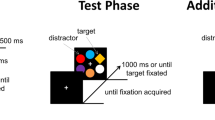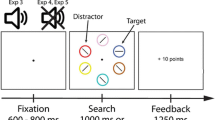Abstract
Attention is automatically drawn to stimulus features previously associated with reward, a phenomenon referred to as value-driven attentional capture. To date, value-driven attentional capture has been studied exclusively by manipulating stimulus–reward contingencies in an experimental setting. Although practical and intuitively appealing, this approach poses theoretical challenges to understanding the broader impact of reward on attention in everyday life. These challenges arise from the fact that associative learning between a given visual feature and reward is not limited to the context of an experiment, yet such extra-experimental learning is completely ignored in studies of value-driven attention. How is it, then, that experimentally established reward associations even influence attention, seemingly overshadowing any prior learning about particular features and rewards? And how do the effects of this experimental learning persist over long periods of time, in spite of all the intervening experiences outside of the lab that might interfere with the learning? One potential answer to these questions is that value-driven attention is context specific, such that different contexts evoke different value priors that the attention system uses to assign priority. In the present study, I directly tested this hypothesis. The results show that the same stimulus feature either does or does not capture attention, depending on whether it has been rewarded specifically in the context within which it appears. The findings provide insight into how multiple reward structures can efficiently guide attention with minimal interference.


Similar content being viewed by others
References
Anderson, B. A. (2013). A value-driven mechanism of attentional selection. Journal of Vision, 13(3), 1–16. doi:10.1167/13.3.7
Anderson, B. A., Faulkner, M. L., Rilee, J. J., Yantis, S., & Marvel, C. L. (2013). Attentional bias for non-drug reward is magnified in addiction. Experimental and Clinical Psychopharmacology, 21, 499–506.
Anderson, B. A., Laurent, P. A., & Yantis, S. (2011a). Learned value magnifies salience-based attentional capture. PloS One, 6, e27926. doi:10.1371/journal.pone.0027926
Anderson, B. A., Laurent, P. A., & Yantis, S. (2011b). Value-driven attentional capture. Proceedings of the National Academy of Sciences, 108, 10367–10371.
Anderson, B. A., Laurent, P. A., & Yantis, S. (2012). Generalization of value-based attentional priority. Visual Cognition, 20, 647–658.
Anderson, B. A., & Yantis, S. (2012). Value-driven attentional and oculomotor capture during goal-directed, unconstrained viewing. Attention, Perception, & Psychophysics, 74, 1644–1653. doi:10.3758/s13414-012-0348-2
Anderson, B. A., & Yantis, S. (2013). Persistence of value-driven attentional capture. Journal of Experimental Psychology: Human Perception and Performance, 39, 6–9. doi:10.1037/a0030860
Brainard, D. H. (1997). The Psychophysics Toolbox. Spatial Vision, 10, 433–436. doi:10.1163/156856897X00357
Cosman, J. D., & Vecera, S. P. (2013). Context-dependent control over attentional capture. Journal of Experimental Psychology: Human Perception and Performance, 39, 836–848.
Della Libera, C., & Chelazzi, L. (2006). Visual selective attention and the effects of monetary reward. Psychological Science, 17, 222–227. doi:10.1111/j.1467-9280.2006.01689.x
Della Libera, C., & Chelazzi, L. (2009). Learning to attend and to ignore is a matter of gains and losses. Psychological Science, 20, 778–784. doi:10.1111/j.1467-9280.2009.02360.x
Failing, M. F., & Theeuwes, J. (2014). Exogenous visual orienting by reward. Journal of Vision, 14(5), 6–9. doi:10.1167/14.5.6
Field, M., & Cox, W. M. (2008). Attentional bias in addictive behaviors: A review of its development, causes, and consequences. Drug and Alcohol Dependence, 97, 1–20. doi:10.1016/j.drugalcdep.2008.03.030
Folk, C. L., Remington, R. W., & Johnston, J. C. (1992). Involuntary covert orienting is contingent on attentional control settings. Journal of Experimental Psychology: Human Perception and Performance, 18, 1030–1044. doi:10.1037/0096-1523.18.4.1030
Hickey, C., Chelazzi, L., & Theeuwes, J. (2010). Reward changes salience in human vision via the anterior cingulate. Journal of Neuroscience, 30, 11096–11103. doi:10.1523/JNEUROSCI.1026-10.2010
Kiss, M., Driver, J., & Eimer, M. (2009). Reward priority of visual target singletons modulates event-related potential signatures of attentional selection. Psychological Science, 20, 245–251. doi:10.1111/j.1467-9280.2009.02281.x
Krebs, R. M., Boehler, C. N., & Woldorff, M. G. (2010). The influence of reward associations on conflict processing in the Stroop task. Cognition, 117, 341–347.
Lee, J., & Shomstein, S. (2014). Reward-based transfer from bottom-up to top-down search tasks. Psychological Science, 25, 466–475.
Maunsell, J. H. R. (2004). Neuronal representations of cognitive state: Reward or attention? Trends in Cognitive Science, 8, 261–265. doi:10.1016/j.tics.2004.04.003
Muhle-Karbe, P. S., & Krebs, R. M. (2012). On the influence of reward on action-effect binding. Frontiers in Psychology, 3, 450.
Qi, S., Zeng, Q., Ding, C., & Li, H. (2013). Neural correlates of reward-driven attentional capture in visual search. Brain Research, 1532, 32–43.
Raymond, J. E., & O’Brien, J. L. (2009). Selective visual attention and motivation: The consequences of value learning in an attentional blink task. Psychological Science, 20, 981–988. doi:10.1111/j.1467-9280.2009.02391.x
Robinson, T. E., & Berridge, K. C. (1993). What is the role of dopamine in reward: hedonics, learning, or incentive salience? Brain Research Reviews, 18, 247–291.
Rutherford, H. J. V., O’Brien, J. L., & Raymond, J. E. (2010). Value associations of irrelevant stimuli modify rapid visual orienting. Psychonomic Bulletin & Review, 17, 536–542. doi:10.3758/PBR.17.4.536
Sali, A. W., Anderson, B. A., & Yantis, S. (2014). The role of reward prediction in the control of attention. Journal of Experimental Psychology: Human Perception and Performance, 40, 1654–1664. doi:10.1037/a0037267
Serences, J. T. (2008). Value-based modulations in human visual cortex. Neuron, 60, 1169–1181.
Theeuwes, J. (1992). Perceptual selectivity for color and form. Perception & Psychophysics, 51, 599–606. doi:10.3758/BF03211656
Theeuwes, J., & Belopolsky, A. V. (2012). Reward grabs the eye: Oculomotor capture by rewarding stimuli. Vision Research, 74, 80–85.
Author note
This research was supported by NIH Grant Nos. F31-DA033754 and R01-DA013165.
Author information
Authors and Affiliations
Corresponding author
Appendix
Appendix
Which option do you believe best describes the part of the experiment in which you were earning money (please choose only one):
-
(1)
The red circle was generally worth more than the green circle regardless of what the background was.
-
(2)
The green circle was generally worth more than the red circle regardless of what the background was.
-
(3)
The two circles were worth the same overall, but one color was worth more when it appeared on the forest background and the other was worth more when it appeared on the city background.
-
(4)
Both color circles were generally worth more when presented on the forest background.
-
(5)
Both color circles were generally worth more when presented on the city background.
-
(6)
How much money I received was random and unrelated to the background.
Rights and permissions
About this article
Cite this article
Anderson, B.A. Value-driven attentional priority is context specific. Psychon Bull Rev 22, 750–756 (2015). https://doi.org/10.3758/s13423-014-0724-0
Published:
Issue Date:
DOI: https://doi.org/10.3758/s13423-014-0724-0




